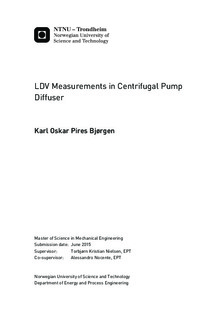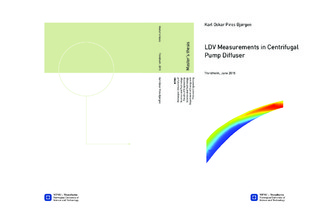| dc.contributor.advisor | Nielsen, Torbjørn Kristian | |
| dc.contributor.advisor | Nocente, Alessandro | |
| dc.contributor.author | Bjørgen, Karl Oskar Pires | |
| dc.date.accessioned | 2015-10-05T14:51:15Z | |
| dc.date.available | 2015-10-05T14:51:15Z | |
| dc.date.created | 2015-06-11 | |
| dc.date.issued | 2015 | |
| dc.identifier | ntnudaim:13140 | |
| dc.identifier.uri | http://hdl.handle.net/11250/2350101 | |
| dc.description.abstract | This thesis describes experimental research on the flow inside a vaned diffuser of a centrifugal pump. The measurements were conducted inside one of the ten curved diffuser channels on the single-stage centrifugal pump test rig located at the Water Power Laboratory at the Norwegian University of Science and Technology (NTNU). The measuring technique used during the experiment was laser Doppler velocimetry (LDV), providing velocity data with a high spatial resolution and accuracy. Procedures for operating the test rig and the LDV system are included in the thesis. Detailed quantification of the two-dimensional steady flow is represented as the ensemble-averaged velocity and the root-mean-square (RMS) of the velocity fluctuations at design point and off-design point. Visualization of the flow properties are presented as velocity magnitude plots and velocity vector plots. The results show a well-behaved flow without flow separation at the diffuser walls when operating at design point and off-design point. However, the flow appears to be highly three-dimensional and fluctuating throughout the entire diffuser channel, which is expected in a curved diffuser. The main characteristic of the observed flow is a high velocity core near the concave wall, persisting until the outlet of the diffuser channel. Also a near-stagnation condition of the flow in a low velocity region near the convex wall is observed. The velocity fluctuation distribution has a characteristic S-shape in the upstream part of the diffuser with peak values located at high viscous shear stress zones, while in the downstream part it is uniformly distributed. The results show an overall good repeatability, especially for the downstream part of the diffuser channel, while the data acquired in the upstream part are more scattered. As the purpose of this thesis is to compare the measured velocity data with a Computational Fluid Dynamics (CFD) simulation, the reliability of the data is paramount. Based on the evaluation of the experimental setup and the uncertainty analysis presented in this thesis, the results are concluded to be suited for the intended purpose. | |
| dc.language | eng | |
| dc.publisher | NTNU | |
| dc.subject | Produktutvikling og produksjon, Industriell mekanikk | |
| dc.title | LDV Measurements in Centrifugal Pump Diffuser | |
| dc.type | Master thesis | |
| dc.source.pagenumber | 173 | |

